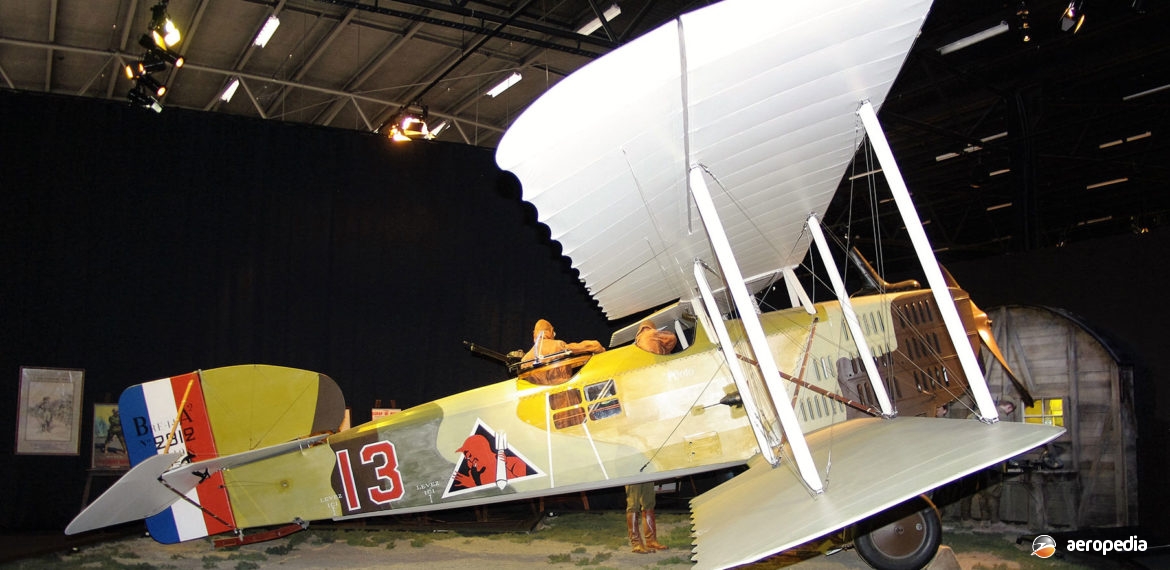Photograph:
Breguet 14 replica at the Omaka Heritage Centre, NZ in 2012 (David C Eyre)
Country of origin:
France
Description:
Medium range bomber
Power Plant:
One 224 kw (300 hp) Renault 12Fe 12-cylinder VEE liquid-cooled engine
Specifications:
- Wingspan [upper]: 14.36 m (47 ft 1¼ in)
- Wingspan [lower]: 12.4 m(40 ft 8 in)
- Length: 8.87 m (29 ft 1¼ in)
- Height: 3.3 m (10 ft 10 in)
- Wing area: 47.5 m² (511.3 sq ft)
- Max speed at 2,000 m (6,560 ft): 175 km/h (109 mph)
- Max speed at 5,000 m (16,404 ft): 156 km/h (97 mph)
- Stalling speed: 82 km/h (51 mph)
- Time to 2,000 m (6,560 ft): 6 mins 50 secs
- Time to 4,000 m (13,123 ft): 29 mins
- Service ceiling: 6,000 m (19,685 ft)
- Endurance: 2 hrs 45 mins
- Fuel capacity: 370 litres (81 Imp gals)
- Oil capacity: 26 litres (5.7 Imp gals)
- Empty weight: 1,010 kg (2,227 lb)
- Loaded weight: 1,536 kg (3,386 lb)
Armament:
One fixed 7.7 mm (0.303 in) Vickers machine gun; two flexible 7.7 mm (0.303 in)
machine guns operated by observer; up to 300 kg (661 lb) of bombs
History:
In 1916 Breguet in France began the design of the Bre.14 series, the type entering production in March 1917 and continuing to be produced in a variety of models up to 1928. The prototype Model XIV flew on 21 November 1916.
Two basic models were built, the Bre.14A.2 for reconnaissance fitted with cameras and a radio transmitter, which had provision for four light bombs; and the Bre.14B.2, which was a bomber variant.
Construction of the fuselage was of dural steel and wood, the wings being fabric covered.
Some 5,300 examples of the series was constructed up to December 1918 and many equipped French units which were based as occupation forces in Germany in 1919. Others operated with French units which intervened in the Russian Civil War after the 1917 Revolution. A small number had Fiat engines, and many were exported and saw service against Syrian and Moroccan insurgents. A couple was used for long distance flights.
In May 1926 a Breguet 14B.2 arrived in New Guinea on board the Dutch ship ‘Omalhout’. The 14B.2 was originally a World War I two-seat day bomber built in France with a 224 kw (300 hp) Renault 12Fe engine and, as a bomber, it could carry 318 kg (700 lb) of bombs. The aircraft in question was a war surplus aircraft named ‘Ern’ modified for civil purposes by the Yackey Aircraft Company of Maywood, Illinois, and fitted with a 298 kw (400 hp) Liberty VEE-12-cylinder engine. Fitted with floats, it was flown by Messrs H H Hoyte with A E Hamer as mechanic.
The aircraft was operated for the Dr Matthew W Stirling Expedition to Papua New Guinea, which was sponsored by the Smithsonian Institute in Washington DC. The primary purpose of the expedition was to locate, film and describe tribes of Pygmies that were thought to exist in the Carstensz Toppen area of the Nassau range, and to map the area. In Java the group was joined by a team of Dutch scientists and became known as The Netherlands – American Expedition.
The aircraft was used for reconnaissance, and for ferrying supplies to remote areas, being able to carry 325 kg (716 lb) at a time. Eventually the aircraft was retired due to deterioration of the glue-bonded wooden floats and was beached at Batavia Camp where it was abandoned, only the engine being salvaged.
A replica of a Model 14B.2 has been airworthy in France, where it has been flown as F-AZBP, this being one of three replicas constructed. Built in France in 1980 by Roland Payen for Salis Aviation, it was used for a television series.
The type was used from 1919 to 1937 by the Royal Thai Air Force and a replica (previously flown as F-AZBH) has been on display at the RTAF Museum at Don Muang. It flew with a Hispano 12X 12-cylinder engine.
Some 8,000 examples were completed originally but few survive. One has been displayed in France in a museum at Le Bourget. One of the replicas of the Model 14A.2 was obtained from Europe by the 14-18 Heritage Trust at Omaka in New Zealand, spending a little time with The Vintage Aviator Ltd to upgrade its finish and to paint it in a colour scheme used by the 96th Aero Squadron of the United States Army Air Corps (USAAC). On completion it was placed on display in the Omaka Aviation Heritage Centre at Blenheim.
An original example survives in Finland. This aircraft was one of 20 examples supplied to Finland in 1919 and these aircraft were mostly fitted with the Fiat A12-bis six-cylinder in-line engine which provided 224 kw (300-hp) and a maximum of 239 kw (320 hp) for military purposes. This aircraft (serial 3C30) has been stored at the Vesivehmaa storage centre awaiting restoration.

